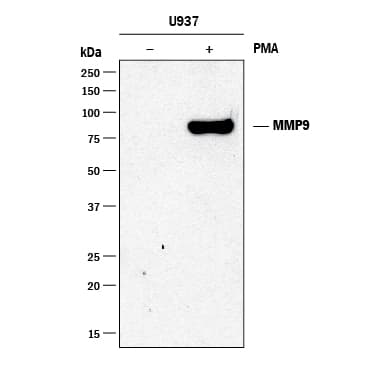 全部商品分类
全部商品分类



Scientific Data
 View Larger
View LargerDetection of Human MMP‑9 by Western Blot. Western blot shows lysates of U937 human histiocytic lymphoma cell line untreated (-) or treated (+) with 5 ng/mL PMA for 24 hours. PVDF membrane was probed with 2 µg/mL of Mouse Anti-Human MMP-9 Monoclonal Antibody (Catalog # MAB911R) followed by HRP-conjugated Anti-Mouse IgG Secondary Antibody (Catalog # HAF018). A specific band was detected for MMP-9 at approximately 90 kDa (as indicated). This experiment was conducted under reducing conditions and using Immunoblot Buffer Group 1.
Human MMP-9 Antibody Summary
Applications
Please Note: Optimal dilutions should be determined by each laboratory for each application. General Protocols are available in the Technical Information section on our website.

Background: MMP-9
Matrix metalloproteinases are a family of zinc and calcium dependent endopeptidases with the combined ability to degrade all the components of the extracellular matrix. MMP-9 (Gelatinase B) can degrade a broad range of substrates including gelatin, collagen types IV and V, elastin and proteoglycan core protein. It is believed to act synergistically with interstitial collagenase (MMP-1) in the degradation of fibrillar collagens as it degrades their denatured gelatin forms. MMP-9 is produced by keratinocytes, monocytes, macrophages and PMN leukocytes. MMP-9 is present in most cases of inflammatory responses. Structurally, MMP-9 maybe be divided into five distinct domains: a pro-domain which is cleaved upon activation, a gelatin-binding domain consisting of three contiguous fibronectin type II units, a catalytic domain containing the zinc binding site, a proline-rich linker region, and a carboxyl terminal hemopexin-like domain.

Preparation and Storage
- 12 months from date of receipt, -20 to -70 °C as supplied.
- 1 month, 2 to 8 °C under sterile conditions after reconstitution.
- 6 months, -20 to -70 °C under sterile conditions after reconstitution.







 用小程序,查商品更便捷
用小程序,查商品更便捷




